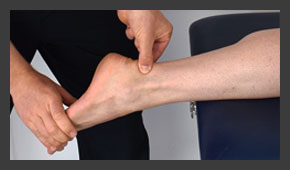(THOUSAND OAKS, CA) - A local foot and ankle surgeon has a message for Baby Boomers now getting back into fitness and sport: Get your ankles checked for chronic disability caused by sprains and other injuries that might not have healed properly years ago. According to Jeffrey S. Hurless DPM, a member of the American College of Foot and Ankle Surgeons, many who have suffered ankle sprains in the past could be at risk for more serious damage as they age and try to stay in good physical condition. It is estimated that one in four sports injuries involves the foot or ankle, and a majority of them occur from incomplete rehabilitation of earlier injuries. "Many older adult athletes who have had a previous injury that wasn't fully rehabilitated may experience swelling and pain as they increase their physical activity," said Dr. Hurless. "But pain isn't normal in the ankle area, even if you're starting to get back in shape."
Dr. Hurless added that both serious athletes and weekend sports participants often misunderstand how serious a sprain can be, and they rush back into action without taking time to rehabilitate the injury properly. "A sprain that happened years ago can leave residual weakness that isn't noticed in normal daily activity, but subjecting the ankle to rigorous physical activity can further damage improperly healed ligaments, and cause persistent pain and swelling." He said, "for anyone hoping to regain past athletic fitness, it's recommended that you have that old ankle injury checked out before becoming active again." High quality orthopedic walking shoes during exercise and normal activity will assist in keeping the foot and ankle in proper mobility and function. Some sprains are severe enough to strain or tear the tendons on the outside of the ankle, called the peroneal tendons.
Research shows that more than 85 percent of athletes who had surgery to repair a torn peroneal tendon were able to return to full sporting activity within three months after the procedure. "Peroneal tendon tears are an overlooked cause of lateral ankle pain," said Dr. Hurless. "Although surgery for athletically active patients shouldn't be taken lightly, surgical repair of the peroneal tendons is proving to be very successful in helping athletes with serious ankle problems return to full activity." Dr. Hurless added that persistent pain and tenderness after a sprain, especially if the individual felt a 'pop' on the outside of the ankle and couldn't stand tiptoe, might be a warning sign that the tendon is torn or split. The injury is best diagnosed with an MRI exam. Products for ankle pain and orthopedic shoes can be found on www.healthyfeetstore.com
Written by
Dr. Jeffrey S. Hurless
DPM, FACFAS Board Certified Foot & Ankle Surgeon/Podiatrist
Medical Director, HealthyFeetStore.com
 |
 |
